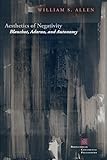Aesthetics of Negativity : Blanchot, Adorno, and Autonomy / William S. Allen.
Material type: TextSeries: Perspectives in Continental PhilosophyPublisher: New York, NY : Fordham University Press, [2016]Copyright date: ©2016Description: 1 online resource (338 p.)Content type:
TextSeries: Perspectives in Continental PhilosophyPublisher: New York, NY : Fordham University Press, [2016]Copyright date: ©2016Description: 1 online resource (338 p.)Content type: - 9780823269280
- 9780823269310
- 149 23
- B828.25 .A45 2016
- online - DeGruyter
- Issued also in print.
| Item type | Current library | Call number | URL | Status | Notes | Barcode | |
|---|---|---|---|---|---|---|---|
 eBook
eBook
|
Biblioteca "Angelicum" Pont. Univ. S.Tommaso d'Aquino Nuvola online | online - DeGruyter (Browse shelf(Opens below)) | Online access | Not for loan (Accesso limitato) | Accesso per gli utenti autorizzati / Access for authorized users | (dgr)9780823269310 |
Browsing Biblioteca "Angelicum" Pont. Univ. S.Tommaso d'Aquino shelves, Shelving location: Nuvola online Close shelf browser (Hides shelf browser)

|

|

|

|

|

|

|
||
| online - DeGruyter Chasing Ghosts : A Memoir of a Father, Gone to War / | online - DeGruyter Too Great a Burden to Bear : The Struggle and Failure of the Freedmen's Bureau in Texas / | online - DeGruyter Academics in Action! : A Model for Community-Engaged Research, Teaching, and Service / | online - DeGruyter Aesthetics of Negativity : Blanchot, Adorno, and Autonomy / | online - DeGruyter The Entrapments of Form : Cruelty and Modern Literature / | online - DeGruyter Nostalgia : When Are We Ever at Home? / | online - DeGruyter Dissonance : Auditory Aesthetics in Ancient Greece / |
Frontmatter -- Contents -- Abbreviations -- Acknowledgments -- Introduction: Abstract and Concrete Modernity -- PART I. Contre- Temps -- 1. Autonomous Literature -- 2. The Obscurities of Artistic Innovation -- PART II. Negative Spaces -- 3. Dead Transcendence -- 4. An Image of Thought in Thomas l'Obscur -- 5. Indifferent Reading in Aminadab -- PART III. Material Ambiguity -- 6. The Language-Like Quality of the Artwork -- 7. The Possibility of Speculative Writing -- PART IV. Grey Literature -- 8. Echo Location -- 9. The Negativity of Thinking through Language -- Appendix: Thomas l'Obscur, Chapter 1 -- Notes -- Bibliography -- Index
restricted access online access with authorization star
http://purl.org/coar/access_right/c_16ec
Maurice Blanchot and Theodor W. Adorno are among the most difficult but also the most profound thinkers in twentieth-century aesthetics. While their methods and perspectives differ widely, they share a concern with the negativity of the artwork conceived in terms of either its experience and possibility or its critical expression. Such negativity is neither nihilistic nor pessimistic but concerns the status of the artwork and its autonomy in relation to its context or its experience. For both Blanchot and Adorno negativity is the key to understanding the status of the artwork in post-Kantian aesthetics and, although it indicates how art expresses critical possibilities, albeit negatively, it also shows that art bears an irreducible ambiguity such that its meaning can always negate itself. This ambiguity takes on an added material significance when considered in relation to language as the negativity of the work becomes aesthetic in the further sense of being both sensible and experimental, and in doing so the language of the literary work becomes a form of thinking that enables materiality to be thought in its ambiguity.In a series of rich and compelling readings, William S. Allen shows how an original and rigorous mode of thinking arises within Blanchot's early writings and how Adorno's aesthetics depends on a relation between language and materiality that has been widely overlooked. Furthermore, by reconsidering the problem of the autonomous work of art in terms of literature, a central issue in modernist aesthetics is given a greater critical and material relevance as a mode of thinking that is abstract and concrete, rigorous and ambiguous. While examples of this kind of writing can be found in the works of Blanchot and Beckett, the demands that such texts place on readers only confirm the challenges and the possibilities that literary autonomy poses to thought.
Issued also in print.
Mode of access: Internet via World Wide Web.
In English.
Description based on online resource; title from PDF title page (publisher's Web site, viewed 02. Mrz 2022)


